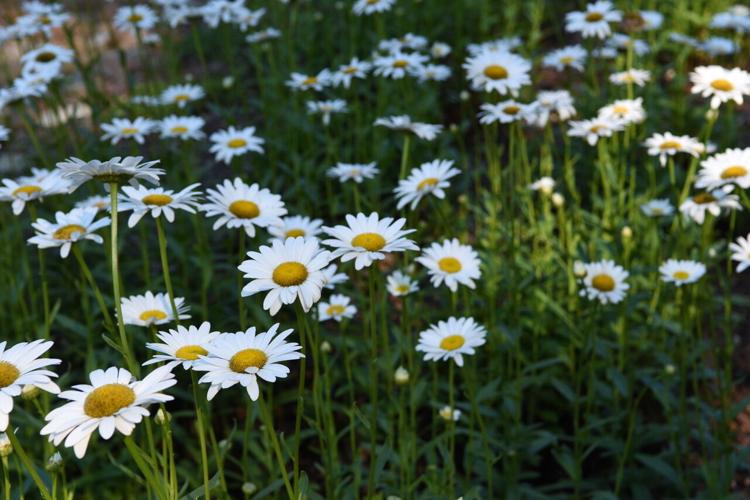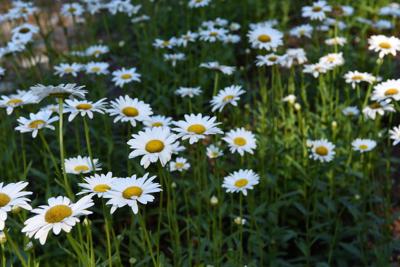I love the magazines and catalogs I get this time of year with all the beautiful photos of new plants that have been introduced. There are some wonderful new plants out there, and I am one who loves to try them. The marketing is working. However, there are also some tried-and-true perennials that will help carry your garden through the summer months.

Brunneras have pretty, dainty, blue flowers that are delicate and graceful.
I know I have mentioned brunnera before for the shade garden. Jack Frost was the first one I planted, and I treasure it. Now, Queen of Hearts has captured my heart. These work well with hostas, solomon seal, pulmoraria and foam flowers. Brunneras have pretty, dainty, blue flowers that are delicate and graceful — I grow them for their foliage that carries them through the summer when they are not in bloom. They all like rich garden soil that does not dry out completely, and they prefer shade or dappled light. Add a few ferns in here and you really will create a lovely, cool-looking shade garden.
Catnip (catmint or nepeta) is a gray-green, aromatic foliage plant that gives way to a plethora of soft lavender-blue flowers. Walker’s Low is one that has been around for years and known to be hardy. Cat’s Pajamas is a newer one that is smaller in scale and blooms about two to three weeks earlier than other catnips.
The ball-shaped habit carries long, dark flower stems that support indigo blue flowers. Unlike older varieties that only produce flowers at the top of the stems, Cat’s Pajamas has blooms that go from the soil to the tips of the stems. Plus, the aromatic leaves keep deer and rabbits away. Any catnip will make a dramatic statement, but if you have a vegetable garden catnips go great with collard greens. The oils of the catnip repel flea beetles that tend to eat the collard leaves.
Becky shasta daisies are a real staple in any garden and are prized for their durability in the hot, humid summers of the south and cold tolerance in the north. They have large, single white blooms that produce a strong stem great for cutting. These cheery flowers begin to appear in early summer and continue for several months with deadheading. They look great and have the same growing conditions as purple coneflowers, bee balm and sages.
Becky is not the only shasta daisy that you can find these days. A new double is Marshmallow which has a puffy look just like its namesake. Large bright-white flowers absolutely cover this medium-sized plant. Then there is Spun Silk, which brings a wild new look to the classic shasta daisy. The narrow petals have fringed edges that create the "spider" look.

Sedum Autumn Joy blooms in the late summer and is pretty through the fall.
A hardy perennial that has been a staple for years is black-eyed Susan. They have a long season of bloom and a sturdy, upright habit. These, too, love sun and will provide a lot of color in the late-summer garden. The gold, daisylike flowers have a distinct dark-brown center cone and are held on a branching stem. They make a wonderful cut flower, but if you want to attract birds leave the flowers after they finish blooming so the birds can enjoy the seeds through the winter. These seeds are a favorite for small birds. Black-eyed Susans look great with phlox, asters, shasta daisies, Russian sage as well as summer annuals like zinnias.
As fall approaches, sedums come to mind as plants that will carry you though to the end of summer when many other perennials have stopped flowering. Autumn Joy has been around for years and produces delicate, bright-pink flowers on large heads that age into a beautiful copper color. Autumn Joy is a stout plant with succulent foliage that pairs well with ornamental grasses and against the deep-green leaves of summer perennials.
Proven Winners have come up with a range of new sedums that you might want to try. They have several series of different ones like the Rock and Round, Rock and Low, and Rock and Grow. Some are very low-growing and others are as tall as 26 inches. The foliage ranges from lime green to blue-green to a very dark plum that looks almost black. The flowers are also interesting. Most are in the red-to-pink range, but they have one that is yellow.
There are still two plants that you should have in your garden for fall. Asters and hardy garden mums are two that I really prize. Asters are long-lived perennials that can become a permanent part of your landscape. These fast-growers will put on a good fall display of color the first year, and once they are established, they will give color for many years.

Black-eyed Susans and Becky shasta daisies create a lovely combination in the summer garden.
For splashes of warm autumn colors, hardy chrysanthemums are worth finding. I am not talking about the chrysanthemums that you see all over town in the fall. I am talking about ones that you plant in the spring that will return year after year. In very recent years, varieties have been developed that will last for years in the garden. There used to be just a few, like Sheffield Pink, but today there are many more varieties in a range of colors. These new mums, when planted in the spring, will reach full size and flower their first fall. Few plants can brighten up the fall garden like hardy garden mums.
If you try to find a few of the plants I have mentioned, you could have a lovely display of color throughout the summer and well into the fall.














